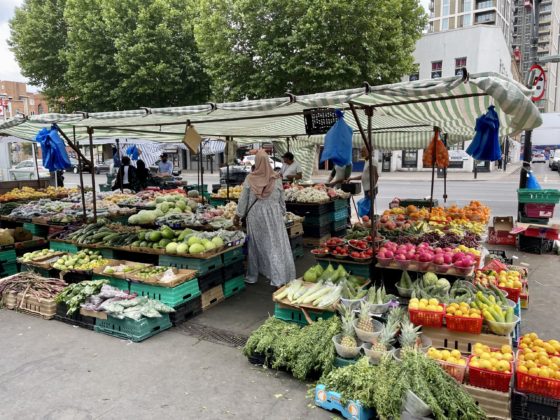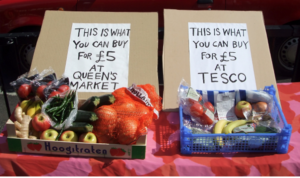
Why Markets are so important for our towns and high streets
“The social and economic goals of public markets are intertwined in a way unlike those of any other civic institution or commercial entity”
Ford Foundation, 2003
Traditional retailing in town centres has been in decline for over 20 years and this is reflected by an increase in empty shops, which in some areas might be as high as one in three (source Local Data Company). The need to create dynamic, engaging and experiential space in town centres is therefore critical to driving footfall. The work we do at Didobi has shown how markets are a key part of delivering this through their functional, symbolic and experiential attributes.
Street markets provide important value retail purchase opportunities for people and a 2018 New Economics Foundation report states that they are “particularly important to lower income, marginalised and vulnerable people, providing access to good quality, healthy and affordable fresh food, opportunities for social and cultural interaction and relatively low-cost and accessible trading”.
Similarly, markets have an important role in building stronger communities. A 2006 Joseph Rowntree research paper stresses the importance of markets for building social capital through “the level of social interaction, the strength of social ties, the level of social inclusion and the use of the market by different groups…”




These benefits are key to every town’s recovery from the pandemic and more importantly to help people get through the Cost of Living crisis. Consumer prices, as measured by the Consumer Prices Index (CPI), were 10.1% higher in July 2022 than a year before. The cost of living has been increasing across the UK since early 2021. The annual rate of inflation was the highest it has been since 1982 in July 2022, affecting the affordability of goods and services for households. Of greater concern is that we have yet to reach peak inflation!

Markets have an important role to play in supporting:
• Local jobs and entrepreneurs
• Increased local spending and the creation of a more circular economy
• People’s sense of place and local identity
• A flexible model with low entry costs that helps start-ups
To effectively manage, promote and brand urban places it is necessary to understand the distinctive and unique features of the physical place and its consumer groups which might be residents, visitors or workers.
The success of markets is not just driven by the mix, offer and catchment but is also dependent on transport (accessibility) and infrastructural services such as parking, cleaning, security and layout within the public realm. Underperformance or sub optimal performance on one will have a negative impact on these factors and especially the success of the market.
In large urban centres, markets can perform a similar role to that of an ‘anchor store’ through its central location, offer and ‘theatre’, and have the potential to increase footfall and sales for the wider town centre. Research by the University of Surrey titled ‘Augmenting the urban place brand – On the relationship between markets and town and city centres’ concluded.
“Our research identifies the potential of some markets to provide place attributes that can augment a place brand, casting them as distinctive features that enhance competitiveness and promote the evolution of urban places.”
The research also identified positive and negative spill over effects between a Market and its Town/City Centre.
Positive spillover effects | Negative spillover effects |
Increased footfall/vitalisation of town/city centre | Strain on infrastructure at peak times (traffic, parking, footpaths, waste disposal, street cleaning) |
Increased booking of overnight stays | Competition for existing businesses – creation of secondary, disadvantaged shopping locations |
Increased willingness to spend/consume by customers | Avoidance of town/city centre by local patrons due to crowding |
Higher customer retention time | Disturbance of residents because of increased noise |
Increased attractiveness of the retail and service network (wider retail/service offer, improved atmosphere, better shopping experience) | Safety and security issues due to crowding, and crime |
Increased social interaction between and within place user/stakeholder groups |
|
Medium to promote the town/city and region |
|
A report in 2010 by Regeneris estimated that customers at street markets spent £752 million in other shops in town centres. This gives a multiplier effect of 2.75 with market customers spending on average £1.75 in other shops in the town centre for every £1 they spend in the market.
By way of an example, the New Economics Foundation (2005) found that the total economic contribution to the economy of Lewisham market was over £4 million PA. However, this study does not consider the positive and additional multiplier effects of the market’s activity. For example, of the wages that local employees receive for working at the market, a proportion will be spent locally, further enhancing local economic benefits. The Institute of Place Management strongly suggest that a thorough and intensive study of the extra spending brought by markets could easily approach the 3.0 multiplier often now observed in the USA and Canada.
Social importance
The 2010 London-wide study of markets showed there was a correlation between the most deprived areas of inner London in terms of income, employment and health, and the location of street markets, which was explained by the availability of affordable food in markets.
“Markets provide variety and diversity, history and character. They are an essential part of Londoners’ everyday experience of the capital, offering a breadth of products and services that local people depend on. They are an expression of our communities and who we are. They help build a strong sense of local identity. And they are also a source of fresh and healthy food, as well as important meeting places where people from different backgrounds can come together.”
Sadiq Khan, Mayor of London 2017

Now, more than ever before, is it critical for towns and high streets to have a strong market both in terms of the economic necessity to buy at the best possible price but also for the social cohesion and community engagement that markets bring. Markets are often the starting point of many successful businesses. Examples include Marks & Spencer, Dunelm, Poundland and Superdry. They are also an important training ground for people who work on them as I am sure Sir Alan Sugar will tell you!
We support a number of councils with their Markets Strategy and creating an evidence base to monitor and evaluate their importance. If you feel you need some independent, evidence led and community drive, help then let’s have a chat.






Leave a comment: